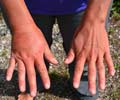According to a study chronic pain in parents appears to be associated with chronic nonspecific pain and chronic multisite pain in adolescents and young adults.

Gry B. Hoftun, M.D., of the Norwegian University of Science and Technology, Trondheim, Norway, and colleagues examined a possible association of parental chronic pain with chronic pain in adolescents and young adults. They also investigated whether socioeconomic and psychosocial factors could explain any relationship or whether it would be affected by differences in the family structure. The cross-sectional study in a county in Norway included a final study population of 5,370 adolescents or young adults (ages 13 to 18 years) for whom one or both parents participated in an adult survey.
"This study showed that both maternal chronic pain and paternal chronic pain are associated with chronic nonspecific pain and especially with chronic multisite pain in adolescents and young adults. Moreover, we found a substantial increase in pain among offspring for whom both parents reported chronic pain," the authors note.
Maternal chronic pain was associated with chronic nonspecific pain and chronic multisite pain in adolescents in adolescents and young adults (odds ratio, 1.5), while paternal chronic pain was associated with increased odds of pain in adolescents and young adults. The odds of chronic nonspecific pain and chronic multisite pain in adolescents and young adults increased when both parents reported pain, according to the study results.
While adjusting for socioeconomic and psychosocial factors did not change the results, differences in family structure did. Among adolescents and young adults living primarily with their mothers, maternal chronic pain was associated with increased odds of chronic nonspecific pain and chronic multisite pain in children, but no clear association was found with paternal pain, according to the study results.
"In summary, parental chronic pain is associated with adolescent and young adult chronic nonspecific pain and especially chronic multisite pain and suggests a strong relationship between chronic pain in the parent and offspring living together, indicating that family pain models and shared environmental factors are important in the origin of chronic pain," the authors conclude.(Arch Pediatr Adolesc Med. Published online November 19, 2012. doi:10.1001/jamapediatrics.2013.422.)
Advertisement
Editorial: Importance of Family Environment in Pediatric Chronic Pain
Advertisement
"A focus on the development of family and parent interventions for youths with chronic pain should be a research priority. To date, there has been limited development of intervention content directed at other aspects of the family environment, such as parent modeling or family conflict," the authors continue.
"Based on the findings of Hoftun and colleagues, the development and testing of interventions that provide instruction to parents in modifying their own response to their chronic pain (e.g., modeling) will be an important next step," they conclude.(Arch Pediatr Adolesc Med. Published online November 19, 2012. doi:10.1001/jamapediatrics.2013.428.)
Editor's Note: Preparation of this article was supported by grants from the Eunice Kennedy Shriver National Institute of Child Health and Human Development.
Source-Eurekalert












